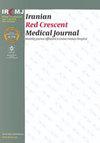喉罩气道滴注地尔硫卓凝胶对超声乳化术后高血压患者血液动力学变化的影响:随机临床试验
IF 0.2
4区 医学
Q3 MEDICINE, GENERAL & INTERNAL
引用次数: 0
摘要
背景:气道控制问题是麻醉相关死亡率和发病率的最常见原因之一。一些设备通过在麻醉患者中建立安全的气道,在手术期间为患者提供充足的氧气供应和通气。其中一种装置是喉罩气道(LMA)。LMA袖带充气后的压迫和疼痛刺激可能导致血液动力学变化。地尔硫卓凝胶用于控制和治疗高血压(HTN)和心律失常,并通过气管粘膜吸收。目的:通过假设地尔硫卓凝胶优于其他用于预防手术中心律失常和血液动力学变化的药物,本研究旨在评估与润滑剂凝胶相比,地尔硫卓凝胶浸渍LMA的效果。方法:本研究是一项双盲、随机的临床试验,对伊朗克尔曼沙赫伊玛目霍梅尼医院80名HTN患者进行超声乳化(phaco)手术。参与者被分配到干预组(用地尔硫卓凝胶浸渍的LMA)和对照组(用润滑剂凝胶浸渍的NMA),通过使用随机数表的40个区块的形式的区块随机方法。在插管前、插管后立即、插管后5分钟和插管后15分钟,在每15分钟一次的手术中,在进入恢复单元时,以及在进入康复单元后15分钟和30分钟测量血液动力学变化(收缩压和舒张压以及心率)。结果:与对照组相比,干预组的平均收缩压和舒张压显著下降。两个研究组的平均心率差异也有显著性差异,但仅在研究开始时(P<0.05)。此外,根据重复测量的方差分析结果,干预组在不同测量时间测量变量的平均值有显著差异(P<0.05)。结论:研究结果支持地尔硫卓凝胶在降低血压,尤其是在手术的最后阶段,减少室性早搏次数和控制正常呼吸方面的有效性。因此,专家和外科医生可以使用地尔硫卓凝胶来控制患者的血液动力学状态。本文章由计算机程序翻译,如有差异,请以英文原文为准。
Efficacy of Laryngeal Mask Airway Impregnation with Diltiazem Gel on Hemodynamic Changes in Patients with Hypertension Undergoing Phacoemulsification Surgery: A Randomized Clinical Trial
Background: Airway control problems are among the most prevalent causes of anesthesia-related mortality and morbidity. Some devices provide patients with adequate oxygen supply and ventilation during surgery by creating a safe airway in anesthetized patients. One of these devices is the laryngeal mask airway (LMA). The compression and painful stimuli following the LMA cuff inflation can lead to hemodynamic changes. Diltiazem gel is used in the control and treatment of hypertension (HTN) and heart arrhythmia and is absorbed through the tracheal mucosa.
Objectives: By assuming that diltiazem gel is superior to other drugs used to prevent arrhythmias and hemodynamic changes during surgery, this study aimed to evaluate the effect of LMA impregnation with diltiazem gel, compared to lubricant gel.
Methods: This study was conducted as a double-blind, randomized clinical trial on 80 participants with HTN who were candidates for phacoemulsification (phaco) surgery in Imam Khomeini Hospital, Kermanshah, Iran. The participants were assigned to an intervention (LMA impregnated with diltiazem gel) and a control group (LMA impregnated with lubricant gel) through the block random method in the form of 40 blocks of 2 using a random-numbers table. Hemodynamic changes (systolic and diastolic blood pressure and heart rate) were measured before, immediately after, 5 min, and 15 min after intubation, during surgery every 15 min, upon entering the recovery unit, and 15 and 30 min after entering the recovery unit.
Results: The mean systolic and diastolic blood pressure in the intervention group showed a significant decrease, compared to that in the control group. A significant difference was also observed in the mean heart rate difference between the two study groups, but only at the beginning of the study (P<0.05). Additionally, according to the results of repeated measures analysis of variance, the mean of the measured variables showed a significant difference at different measurement times in the intervention group (P<0.05).
Conclusion: The findings supported the effectiveness of diltiazem gel in reducing blood pressure, especially in the final stages of surgery, decreasing the number of premature ventricular contractions, and controlling normal breathing. Therefore, specialists and surgeons can use diltiazem gel to control the hemodynamic status of patients.
求助全文
通过发布文献求助,成功后即可免费获取论文全文。
去求助
来源期刊

Iranian Red Crescent Medical Journal
MEDICINE, GENERAL & INTERNAL-
CiteScore
1.16
自引率
0.00%
发文量
0
期刊介绍:
The IRANIAN RED CRESCENT MEDICAL JOURNAL is an international, English language, peer-reviewed journal dealing with general Medicine and Surgery, Disaster Medicine and Health Policy. It is an official Journal of the Iranian Hospital Dubai and is published monthly. The Iranian Red Crescent Medical Journal aims at publishing the high quality materials, both clinical and scientific, on all aspects of Medicine and Surgery
 求助内容:
求助内容: 应助结果提醒方式:
应助结果提醒方式:


